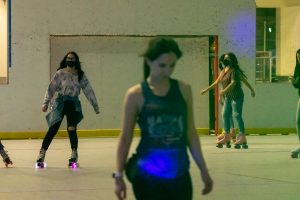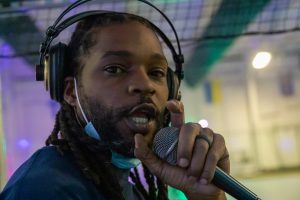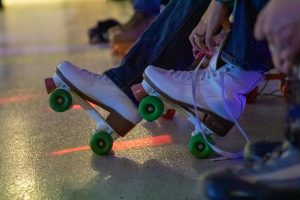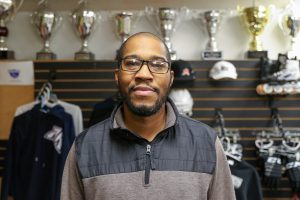- Slug: BC-CNS Adult Skating Nights, 2,300 words.
- 5 photos and captions below.
- 2 graphics here and here.
By Michelle Ailport
Cronkite News
PHOENIX – Loudspeakers blast an eclectic mix of music – from godfather of soul James Brown to the rapper Saweetie – playing in sync with flashing multicolored lights. DJ Selectah Slam adjusts buttons and sliders across a lit-up turntable and soundboard.
“Are you ready?” he chants to a crowd of roller skaters – all in masks – swirling around the floor. It’s after 9 p.m. at the Lab, a basketball gymnasium in Chandler, but this “adult night” is just getting started.
Welcome to roller skating in the age of pandemic.
Before COVID-19, roller skating was experiencing its biggest boom in years, although rinks were facing growing economic pressures to survive. But for DJ Selectah Slam and other entrepreneurs, the pandemic proved to be a blessing in disguise as people looked for ways to entertain themselves.
As skaters navigate shutdowns and reopenings, they’re searching for a place to roll – and a community. Adult skating nights offer just that in metro Phoenix, part of a movement playing out across the country on social media, in some rinks and on the streets.
Adult night has roots in segregation, Black culture
Adult night gets its name from a segregation practice that was common in the 20th century. It was code for “Black night” or “soul night,” when white-owned roller rinks limited Black skaters to a single night a week.
Since then, roller skating has evolved, and today, people of all makeups skate together. Black skating culture still heavily influences the music, skating style, wheels and more.
Diversity is a hallmark of roller skating today. Imagine that a roller-skating rink is a freeway, with lanes for different speeds and styles, and regions have developed their own skate styles.
On the West Coast, “rexing” is when skaters dance backward in figure-8 and hour-glass patterns at high speeds, according to Ginger Mathews, who has traveled to more than 400 roller-skating rinks over eight years as the Skate Critic on Facebook.
On the East Coast, there’s shuffle skating. In Alabama, trucking in trains and trios. In Chicago, JB skating, which Mathews describes as more of a stride.
And then there’s California, Arizona’s neighbor to the west.
“California rolls completely different,” said Terry Currie, aka DJ Selectah Slam, who is based in Arizona but has traveled to other states to roller skate. “They roll in skates that look like Stacy Adams church shoes,” referring to the Oxford-style dress shoes often reserved for church service on Sundays. Major Black artists and groups, including N.W.A. and Dr. Dre, were prominent performers at California roller rinks.
Today, hip hop and rap – and the occasional organ solo, if you’re into an early 20th-century throwback – are still a part of roller-rink playlists.
The Valley has its own roller-skating history and culture, built in part by transplants and those born in Arizona.
Black Midwestern transplants Terry Currie, his brother Anthony Currie and their friend Denice “Niecy” Towns came to Arizona looking for a roller-skating community. Terry was the last of three to come from Chicago in 2008. Niecy was the first, in 2005, followed by Anthony in 2007.
“We can’t go to or live in a city where there’s not roller skating,” Terry Currie said.
In May 2009, the trio founded the Toe Stoppas, whose goal is to bolster the roller-skating scene in metro Phoenix. In the early days, the group had 30 to 40 skaters, promoting itself at comedy clubs and after concerts.
By the early 2010s, the Stoppas had a regular monthly party called “Roll Bounce Sundays,” that drew a couple hundred people. The event became so popular that it eventually took place every other week, and then every week.
Over the last decade, they’ve been paying homage to their Chicago roots by “spoon-feeding” Valley skaters doses of James Brown and outfitting them with well–used “peanut-butter” skates – a term Towns uses to describe the beginner skates that are tan with bright orange wheels and toe stops, and are commonly rented out.
Towns called Arizona a “melting pot” for roller skating because so many people have come from other states. The Toe Stoppas’ skate nights blend these styles from across the country.
“They are very receptive because they haven’t seen anything different,” Anthony Currie said. “We’ve noticed over time that the way that they skate has changed. Arizona is great for jam skating, which is kind of like break dancing on skates. Because we’ve introduced different styles, we’ve seen jam skaters completely change the way that they skate.”
Some people have even bought their own skates to do so, moving beyond the peanut butter training wheels to skates where their favorite sports teams and movies are airbrushed on. Skate plates, the underside of a roller skate, are treasured like the chrome engineering under the hood of a custom car.
“Because we’re from Chicago, we are accustomed to a certain type of skating music that the West Coast and Arizona have not really been introduced to,” Towns said.
Skaters roll to soul, hip hop, R&B classics (such as Johnny Gills’ smooth–gliding “My, My, My”) and new hits. Terry Currie, who is also a DJ, created 4RollersRadio, so even those who can’t make it to the rink can listen and skate to the music that makes them tick.
Starting a grassroots adult night skating group did not come without challenges.
‘His business will not survive’
Terry Currie blames an April 1992 shooting at Skate World in east Phoenix for a downturn in roller rink skating in the Valley. 2nd II None, a rap group from Compton, California, had just finished performing at a nightclub, and the concert-goers migrated to an after-party at the rink.
According to the Phoenix New Times, more than 100 bullets were fired after a gunfight broke out at the rink. One man died from gunfire, and another died in a four-car traffic accident caused by people fleeing the gunfire.
Residents of the nearby neighborhood and the Rancho Ventura Neighborhood Association attributed the shooting to gang activity. Phoenix City Councilwoman Kathy Dubs, who held the District 6 council seat at the time, called for Skate World’s owner to close down his rink, according to an Arizona Republic article from April 1992.
“His business will not survive another incident,” she said then. “He’ll barely survive this one.”
“Because of that, the entire Valley has been a little terrified of hosting adult roller skating events that cater to hip hop, R&B music,” Terry Currie said, referring to stereotypes that persist decades after the shooting.
Skate World shut its doors in 1993. The building now houses a behavioral health clinic.
In west Phoenix, Rollero Family Skating Center, a wood-floor rink, closed in June 2017 because of neglect: Its roof caved in.
Documents from the city of Phoenix revealed that the rink’s roof hadn’t been inspected since 1982, according to a report by KTVK. The family that owned the rink for over 30 years never reopened it.
A few more roller rinks have popped up, including one that doesn’t offer adult-only nights – it’s at North Phoenix Baptist Church at Central Avenue and Bethany Home Road.
But the number of roller-skating rinks in the Valley is nowhere near what it once was, and that’s common in cities elsewhere in the country. Phoenix was once home to a handful of roller rinks – from Sky View Roller Rink on Broadway Road in the 1950s to Roller World and Surfside Skate in the latter half of the century.
Cort Wahlig, president of the Roller Skating Association International and long-time owner of two roller-skating rinks in Delaware, estimates that up to 4,000 roller-skating rinks existed across the United States in the 1970s, considered roller skating’s heyday.
The COVID-19 pandemic has added to the growing number of shut-down rinks, both temporary and permanent, slowing the rebound the industry has experienced since the Great Recession.
“Roller skating itself was on a very high note, and most of (the Roller Skating Association) members were having some of the best years they had had in 10 or 15 years,” Wahlig said. “And me included.”
Then, the pandemic hit in 2020.
“Right up through March 15 when we got shut down.”
Blessing in disguise for grassroots skating
When coronavirus restrictions were first placed on businesses in March 2020, rinks closed their doors to help slow the spread of COVID-19.
The United Skates of America, which owns Great Skate and two Skatelands in the East Valley, received a Paycheck Protection Program loan of $1 million to $2 million. Still, its rinks in Phoenix only had to close temporarily.
Some roller-skating rinks have gotten help from the Roller Skating Association International, which continues to hold weekly town hall meetings and supports roller-rink owners in securing grants and loans like the PPP.
“COVID has been especially hard on us as an industry,” Wahlig said. “(We’ve been trying to) just help our members survive.”
Not all rinks and owners have persevered. For some, the pandemic has been a final nail in the coffin.
“We have really struggled to stay open, and we have lost several rinks to foreclosure, number one,” Wahlig said. “And number two, some of the older rinks just got a little bit tired and said, ‘You know what? This is the time for me to cash out.’”
Wahlig estimates that about 25 to 30 roller-skating rinks across the country have closed during the pandemic, with that number continuing to grow.
For grassroots skating groups like the Toe Stoppas, the pandemic may have been a blessing in disguise. The Stoppas group parted ways with Great Skate in June, and its leaders sought to create their own spaces for roller skating to capitalize on a trend.
“People are buying skates more now than they ever have in the history of roller skating,” Wahlig said. Google searches for roller skates spiked between March and May, signaling an interest for some in a new pandemic activity.
“As a skating rink, we couldn’t even get skates (from distributors) because that many people had bought them to skate outside,” Wahlig said. “To skate in the basement, to skate in the warehouse, wherever they were able to escape.”
Terry Currie agrees. “Anywhere there is a flat surface, they’ll roll,” he said.
Trends like these led the Toe Stoppas to new spaces such as the Lab, a gym in Chandler usually home to basketball tournaments, and Peoria Sportsplex.
“If rinks are cookie cutters, we are a completely different mold,” Terry Currie said.
The Toe Stoppas Facebook group boasts over 1,300 members, with members sharing meet-ups, home-grown roller skating lessons, videos of them skating, and more. Skating lessons and sessions popped up from Queen Creek to Peoria.
“We’ve been doing this for 11 years. And I don’t plan on stopping any time soon,” Terry Currie said. “Growing up in Chicago, that’s how we stayed out of trouble. I want to be able to provide that same release, same outlet, same experience, same fun. It is a family thing.”
In this case, a family is more than what you’re born into, it’s a skate family, he said.
“I want to get that family back together.”
The pandemic won’t stop them from being together, either.
Family, by blood and by skate
Terry Currie had just returned home to spend a few hours with his family after preparing for that night’s skate session when a little girl came calling – “Daddy!”
“Hey baby,” Terry Currie said gently. “We’re going to have fun today.”
His 3-year-old daughter Shaun, who is named after Terry and Anthony Currie’s mother, already has two pairs of roller skates. Skates are like pairs of shoes, replaced not quite as often as feet grow. They skate together weekly as a family.
“I want to raise roller skaters,” Terry Currie said.
For Terry and Anthony Currie, roller skating goes back to when they were little kids. The brothers learned how to skate from their mother, Shaun.
“My mom said, when she had two kids as a single mom, that she wasn’t gonna let us stop her from roller skating,” said Terry, whose first pair was black with thick royal blue laces. “My mom bought them bigger than our feet, and we had to wear multiple pairs of socks to fill in the space until our feet grew into the skates.”
In Chicago, the Currie brothers started off rolling at Glenwood as a family to gospel music, going with their mom until they were old enough to do so on their own. It wasn’t until they were teenagers that they started skating to hip hop and R&B.
For Niecy Towns, roller skating was a family tradition, too. She was 5 when she got her first pair of skates – white with pink laces – which she shared with her younger brother.
“I’ve been skating since I was practically out of the womb,” Niecy said. “My brother would have one shoe and one skate, and so did I. He didn’t care that they were too big, he just wanted to skate.”
Her daughter, L.J., got her first pair of skates when she turned 5 years old, just as Niecy had.
At an event in Chandler, they make room for the joy that comes with lacing up a pair of roller skates and grooving to a favorite song with friends and family on eight wheels.
Towns welcomes skaters as they arrive, followed by eager hellos and how have you beens.
From the sidelines, a young woman laces her low–cut skates, the silver stripes reflecting the rapidly changing colors beaming from the DJ booth. Another live streams on her Instagram page as skaters whir by. On the freshly polished wooden gym floor, an older couple ballroom dances on quad skates, hands locked together. They whip around each other, and they only slow down to occasionally pull their masks back over their noses.
A bright purple glow fades into greens, blues and yellows. From the glass doors that open to the euphoria inside, music echoes softly into the night.
^__=




